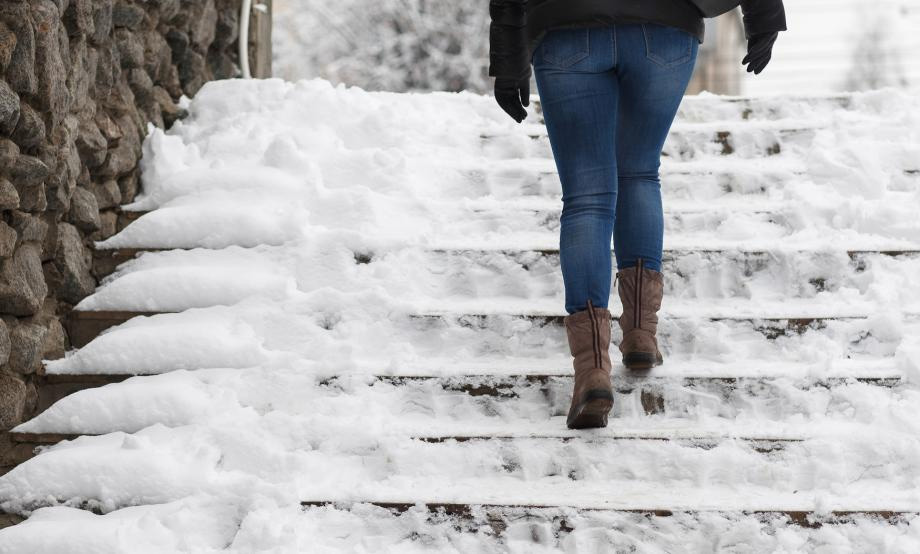This time of year we see a variety of quick-changing weather in Alberta. Cool morning frost. Rainy afternoons. Surprise snowfalls. This unpredictable weather can make you want to pull out your bulky sweaters and pour a cup of tea, but it should also make you more aware of your footing when you go outside.
Fall and winter surfaces tend to be slick, which can cause a higher risk of slips that could lead to injury. Each year over 42,000 Canadian workers get injured due to fall incidents, which represents about 18% of all time-loss injuries, according to the Association of Workers' Compensation Boards of Canada. Over two-thirds of these falls happen on the same level resulting from slips and trips at the ground level.
These sobering statistics are a good reminder that workers need to know how to identify the hazard and prevent the fall. In this blog, we will take a closer look at slips, and how to keep yourself safe during the high-risk winter months.
What causes a slip?
Slips are caused when there isn’t enough friction or traction between your feet and the surface you’re walking on. Common causes of slips include:
- wet or oily floors
- weather hazards such as ice and snow, spills
- loose or unanchored mats
- flooring that lacks the same degree of traction in all areas
How to prevent falls due to slips
The best, and easiest, way to prevent slips is to practice good housekeeping. This includes:
- Cleaning all spills immediately. If you have spilled something on the floor, make sure to properly clean the area as soon as possible. This might involve more than just sweeping, wiping or mopping the floor. Some materials, such as oils, may leave a slick surface even after they have been wiped up, so make sure the surface is safe to walk on before you walk away from cleaning.
- Marking spills and wet areas. If you have spilled something and need to go get cleaning supplies, or if you have just mopped the area and the floor is still wet, make sure you mark the area with a wet floor or spill sign. These signs will help alert others that there is a potential hazard, and let them know that they should take extra precautions when they are moving through the area.
- Mopping or sweeping debris from floors. Even dry materials can be a slip hazard. It’s important to sweep up all dirt, debris, and other items off of floors, especially if they are in high trafficked areas.
- Removing obstacles. Stack any materials neatly and securely so that they won’t fall into pathways or work areas.
- Securing rugs. Tape or tack down all mats, rugs, and carpets that do not lay flat. It is also important to secure all of these rugs so that they don’t slide on the floor under someone’s feet.
- Clearing walkways. With snow and ice during the winter months, you need to take extra care to prevent slipping hazards. You should shovel any snow or ice off of walkways and use winter-grade salt or sand to add traction to high traffic areas.
- Covering cables. Make sure that any cords from power tools and lights don’t pose a tripping hazard. Fasten cords to the floor or keep them away from pathways and work areas.
If you see a slipping hazard, such as a wet floor or an icy area, you can also take extra precautions. To reduce the risk of falling at work, pay attention to your surroundings and walk at a pace that’s suitable for the surface you’re on and the task you’re performing. You can also keep yourself safe by:
- Taking your time. It's important to not feel rushed and to pay attention to where you are going. By taking extra time, you will be able to identify more hazards and prevent potential falls.
- Adjusting your stride. Move at a pace that is suitable for the walking surface and the tasks you are doing. This means that you should walk slower than usual on slick surfaces.
- Using a penguin walk. When you are on a slick surface, you should point your feet pointed slightly outward and take small steps. This is called a "penguin walk" since you shuffle like a penguin when you are walking on a slippery surface. Penguins are great at walking on ice, so they must know something about preventing slips!
- Taking wide turns. If you are going around a corner that is slick, make a wide turn.
- Holding handrails. When you're climbing up or stepping downstairs, make sure you hold onto the handrails. This is especially important if the stairs are covered in ice or snow.
The industry tends to focus on the hazards of working at height, but we also need to take special notice of all of the falls that happen on flat land. If you would like to learn more about how to prevent slips, trips, and falls, check out our Fall Protection Course. This course will provide an overview of fall protection, fall guarding and fall restraints.

